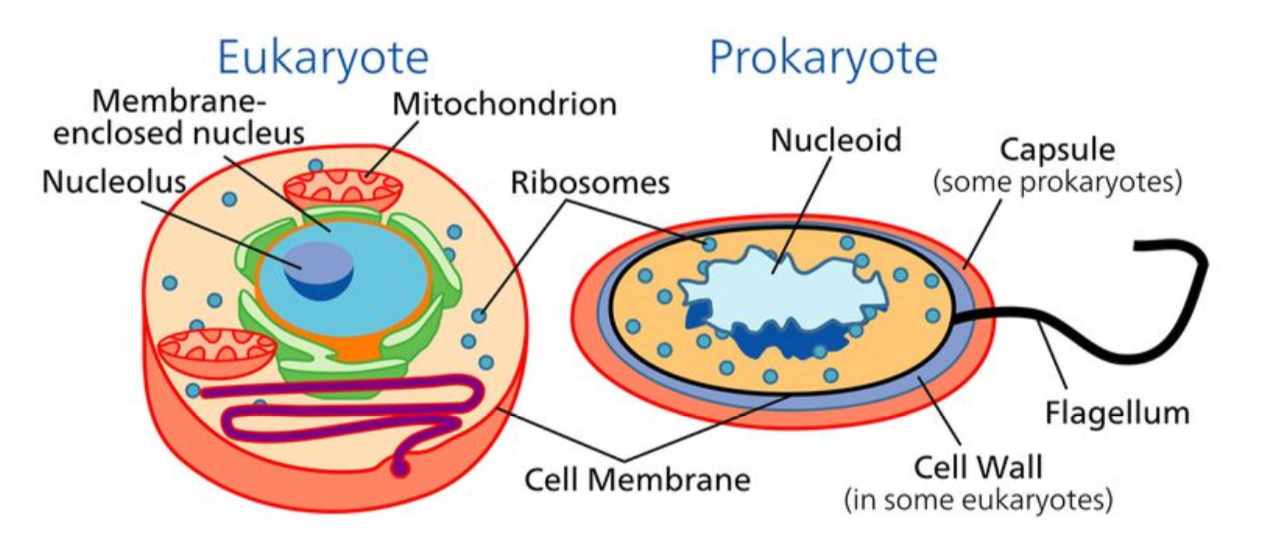
With the revamp of the HSC and Preliminary Biology syllabus, some elements of Year 11 Module 1: Cells as a Basis of Life have changed!
But don’t fret, these changes to the first module actually make it easier to understand more complex concepts down the track.
This is our first taste of the Year 11 Biology course and as you can expect, this module takes us through the basics of cellular biology.
We’ll be exploring cellular structures, their distinguishing features and biochemical processes within cells.
In this article, we’ll give you an overview of Year 11 Biology Module 1, as well as walk you through each of the inquiry questions and even give you some study tips to help you get a Band 6!
So, what are you waiting for? Let’s jump right in!
What are the changes to the Module 1 syllabus?
Overview of Cells as the Basis of Life
Inquiry Question 1
Inquiry Question 2
How to Study for Year 11 Biology Module 1
What are the changes to the Year 11 Biology Module 1 syllabus?
The old syllabus started us off broadly by exploring biological relationships within an ecosystem, then narrowing it down to cellular processes.
This time, we’ve swapped it around, and for good reason!
We now have a logical application of knowledge, by first understanding basic molecular biology, then expanding to understand how cells and cellular processes shape the environment.
Overview of Year 11 Biology Module 1: Cells as the Basis of Life
A great summary for the content in Module 1 is the Content Focus from the syllabus.

The fundamental theme for this module is the characterisation of cells and their associated functions.
Year 11 Biology Module 1 is straightforward, with 2 main topics:
- Cell structure: how different cells and their internal structures are characterised
- Cell function: the coordination of biochemical processes necessary for cells to function and to regulate their internal environment
Inquiry Question 1: What distinguishes one cell from another?
Cells are the basic building blocks of organic life.
They can generally be classed as prokaryotic (unicellular and lacking membrane-bound organelles) or eukaryotic (multicellular and contain a nucleus and membrane-bound organelles).
Here’s a nice diagrammatic summary:

Image from ThoughtCo. Learn about the Different Types of Cells: Prokaryotic and Eukaryotic
Cells can only function with their organelles.
An organelle is a membrane-bound structure within a cell. You can think of organelles within a cell the same way you think about organs in our body – we can’t work without them.
The following table provides a brief overview of cellular organelles:
| Organelle | Function |
|---|---|
| Nucleus | Stores DNA |
| Endoplasmic Reticulum | Produces lipids and proteins and also responsible for detoxification |
| Golgi apparatus | Modifies and exports proteins |
| Peroxisome | Contains enzymes for oxidation of lipids |
| Lysosome | Contains destructive enzymes to digest waste |
These organelles only work at their best when their environment is regulated.
But how is their environment maintained? By the cell membrane!
The ‘fluid mosaic model’ is typically used to describe the arrangement of cell membranes.
Simply put, it is composed of a phospholipid bilayer with various proteins designed to provide a physical barrier between the extracellular and intracellular environment.
Want a study note-taking structure that follows these your inquiry questions? We’ve made an HSC Notion Template with syllabus dot points for you to follow along with in HSC Biology! (P.S. It also has a habit tracker, pomodoro timer, assessment planner, past papers, and more!)
Inquiry Question 2: How do cells coordinate activities within their internal environment and the external environment?
In this inquiry question, we’re branching off our knowledge of the phospholipid bilayer and its function from the first inquiry question. Our goal here is to understand why and how cells regulate their environments.
More specifically, we’ll be investigating passive and active movement of material across the cellular membrane.
Here are the basic definitions that we need to know:
Diffusion: Movement of solute molecules from a region of high concentration to low concentration
Osmosis: Movement of solvent molecules across a semipermeable membrane towards a higher concentration of solute.
These 2 processes can only occur along a concentration gradient where a solute is more concentrated in one area than another.

Image from Socratic Q&A: Why are gradients important in diffusion and osmosis?
NB: Remember that diffusion refers to the movement of solutes whereas osmosis refers to the movement of solvent. They are not interchangeable!
Diffusion and osmosis are usually referred to as passive transport mechanisms (don’t require energy).
Active transport mechanisms (do require energy) are processes such as exocytosis and endocytosis which transport molecules against a concentration gradient.
Sure, cells need energy to perform these functions and there are a number of processes which allow them to harness and produce energy!
To quickly summarise some processes through which organisms can acquire energy:
Photosynthesis
Photosynthesis is a process which uses the radiant energy of the sun along with some other organic compounds such as carbon dioxide to create glucose.
It is used by autotrophic organisms, otherwise known as self-feeders.

Image from Lumen: An overview of Photosynthesis
Cellular respiration
Glucose formed from the processes in photosynthesis need to be broken down into a usable form – Adenosine Triphosphate (ATP) before it can be used.

Image from Philpot Education: Cell Respiration
You can check out this great video for an overview of how cell respiration works! For more info, check out some other videos on HSC Together on photosynthesis and cellular respiration here.
Finally, the last part of inquiry question 2 requires us to learn about enzyme action.
Most enzymes are proteins. They are organic molecules which are used to catalyse or speed up a chemical reaction.
This is achieved by lowering the amount of energy required for a chemical reaction to start, otherwise known as activation energy.
Enzymes act on substrates to form products. They can either combine substrate molecules or separate them.
How to Study for Year 11 Biology Module 1: Cells as the Basis of Life
We’ve put together our top 3 tips for acing Year 11 Biology Module 1: Cells as the Basis of Life!
Tip #1: Completing the puzzle
All the syllabus points in Inquiry Question 1 and Inquiry Question 2 are linked.
Think of a cell as a complete puzzle, with each organelle being a single puzzle piece. Each component has its place and its role. Your puzzle won’t be complete if you’re missing pieces!
When you look at each puzzle piece, think of its shape (structure), then think about how it will fit into the whole set (function).
Tip #2: Clarification is key
It’s difficult to understand a concept if you don’t know what the biological terms mean!
When writing your notes, don’t write down a concept that you aren’t 100% sure of (sure, you might tell yourself you’ll come back to it later but chances are you’ll just end up forgetting about it!).
If you’re unsure about a concept, make sure you clarify it first before you write it down. Then, when you’re looking over your final notes, everything will make sense.
For example, I’ve learnt the processes of photosynthesis and cellular respiration, but I’m still unsure as to how they provide energy! Instead of rote learning these processes from my notes, I do some extra research and identify the products of each process. I find out that glucose is produced from photosynthesis and it is then used in cellular respiration to form ATP which is the primary energy source for living organisms. These 2 processes form a biochemical chain to provide energy!
Tip #3: If in doubt, draw it out
Diagrams are your best friend!
A lot of the time, biological processes are much easier to understand in diagrammatic form.
Having trouble remembering the structure of a phospholipid bilayer? Draw it out!

Image from IB Guides: Membranes
Need some more help understanding Module 1? Get some support with a Biology Tutor in Sydney!
Key Takeaways
Visualise your information! Images of biological structures are much easier to commit to memory than chunks of text.
Understand the links! All these biological concepts are related to one another. Thinking about them as a cohesive whole simplifies individual concepts
Learn the terminology! Familiarise yourself with the key terms.
And that wraps up our guide to Year 11 Biology Module 1: Cells as the Basis of Life — good luck!
Want to achieve a Band 6 in HSC Biology? Check out our tips to scoring one here!
On the hunt for other module guides for Biology?
Check out the ones we’ve created below:
- Module 2: Organisation of Living Things
- Module 3: Biological Diversity
- Module 4: Ecosystem Dynamics
- Module 5: Heredity
- Module 6: Genetic Change
- Module 7: Infectious Disease
- Module 8: Non-infectious Disease and Disorders
Looking for some extra help with HSC Biology?
We pride ourselves on our inspirational HSC coaches and mentors!
We offer tutoring and mentoring for Years K-12 in a variety of subjects, with personalised lessons conducted one-on-one in your home or at one of our state of the art campuses in Hornsby or the Hills!
To find out more and get started with an inspirational tutor and mentor get in touch today!
Give us a ring on 1300 267 888, email us at [email protected] or check us out on TikTok!
Alex Gao is an Art of Smart mentor and blogger who is passionate about teaching students the skills and know-how of high school. Alex has a great interest in the field of Biology, avidly blogging about the topic whilst also aspiring to become a Biomedical Engineer. Alex graduated in 2018 and was listed on the Distinguished Achievers list for Advanced English, Extension 1 English and Biology.


